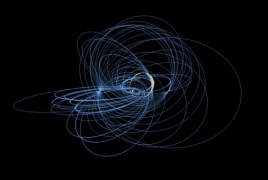
NASA's Cassini spacecraft is beginning a series of "ring grazing" orbits to study Saturn's rings and moons before it makes a death plunge into the planet's atmosphere next year, ABC News said.
Cassini is using the gravitational pull from Saturn's largest moon, Titan, to begin the tilted orbits. Between November 30 and April 22, Cassini will circle over and under the poles of Saturn once every seven days, for a total of 20 times. Engineers have been pumping up Cassini's orbit around Saturn this year to increase its tilt for the mission.
NASA scientists are calling this phase of the mission Cassini's ring-grazing orbits because the spacecraft will be skimming past the outer edge of the rings, where instruments will collect particles and gases as it crosses the ring plane, said Linda Spilker, the Cassini project scientist at NASA's Jet Propulsion Laboratory in Pasadena, California.
Cassini's ring-grazing orbits will offer "unprecedented opportunities" to observe the small moons that orbit the planet near the edges of Saturn's rings, including Pandora, Atlas, Pan and Daphnis. The region on the outer edge of Saturn's main rings has been unexplored until now.

